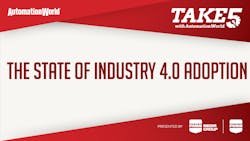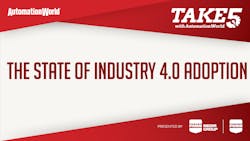The State of Industry 4.0 Adoption — Take Five with Automation World Video

Quick hits:
- The findings in the Molex survey echo previous reports from LNS Research and Deloitte
- 51% of respondents said their companies have well-defined Industry 4.0 strategies
- The remaining challenges relate more to cultural issues and business models than technological barriers
- Article: The State of Industry 4.0 Adoption
- Is Your Company Committing to Digital Transformation?
- 4 Obstacles to Digital Transformation
- Learn about PMMI's OpX leadership network and how it provides solutions for the industry's most pressing challenges.
Hello and welcome to another Take Five with Automation World.
I’m David Miller, senior technical writer for Automation World. Today, we’re going to be examining a State of Industry 4.0 survey by Molex, a supplier of industrial electronics and connectivity technology, and just to put some of its findings into context I’m going to be comparing it to some other similar surveys we’ve covered at Automation World that were conducted in prior years.
So, before we get into the new Molex report – a little history. In 2019, a survey from LNS research found that digital transformation initiatives had already been undertaken by 45% of respondents and another 23% were expecting to begin initiatives within one year. In addition, a similar report published by Deloitte in 2018 found that the biggest remaining barriers to ubiquitous adoption of Industry 4.0 were strategic and operational business issues, rather than technology issues.
Now I mention that because it sets the stage, because what we see in the Molex report is that while some significant progress has been made, the overall outlook remains largely the same.
So, on the whole, 51% of respondents to the Molex survey said that their companies do have well-defined Industry 4.0 strategies, and that does mark a modest increase over the 45% who answered similarly in the 2019 LNS survey. But in the responses it was also the case that executives were significantly more likely to describe their companies Industry 4.0 initiatives as well-defined than managers and OT personnel were. And so what it seems that indicates—and what is borne out in the rest of the survey—is that there is a continuing disconnect between plant-level operators and enterprise-level planners that inhibits the growth of Industry 4.0. And so that issue, I think, echoes the findings from the 2018 Deloitte report, which found operational and business issues being a bigger barrier than technological challenges.
So, digging into the information in the survey in a bit more detail, there are a few other takeaways worth noting.
First of all, when it comes to what companies want to achieve via their industry 4.0 initiatives 69% said they wanted to build better products, 58% wanted to reduce overall manufacturing costs, 53% want to increase revenues, 35% want to offer products at a lower price, and 35% want to decrease time-to-market.
So, let’s contextualize this. What we’re seeing here mirrors certain observations from 2018’s Deloitte report once again. That report found that while 94% of respondents said the need for digital transformation was an imperative for their business, only 68% expected it to actually increase profitability. In other words, they’re investing for defensive reasons – that is, simply to survive – rather than offensive reasons. And what we might surmise is that this is supported by the precedence we see in this new survey for keeping products competitive and cutting costs over and against increasing revenues.
The final things I want to touch on are the challenges that respondents report they continue to face in implementing Industry 4.0 initiatives. And they break down into three categories: Cultural challenges, business model challenges, and technology challenges. When asked which was the most severe for them, 44% of respondents chose organizational and cultural issues, 33% chose business model issues, and 22% chose technology issues.
Now, if you recall, this also mirrors 2018’s Deloitte report – Once again, business and cultural barriers are taking precedence over technological barriers.
Getting more specific, we can unpack each one further. On the cultural front, the biggest reported issues where that leadership is more comfortable with traditional approaches and doesn’t advocate for change. In addition, difficulty hiring personnel with the needed data and analytical skills was also cited.
Regarding business model issues, many reported that the large upfront investments required by Industry 4.0 initiatives make achieving a return-on-investment challenging. Now this is conjecture on my part, but I’d be willing to muster a guess that the prevalence of this difficulty is largely responsible for the uptick we’re currently seeing in as-a-service and pay-for-performance business models which as our viewers know often reduce those upfront costs.
So, before we conclude, I just want to note one more thing. Despite the many barriers that still exist, the respondents surveyed were still overwhelmingly positive about the potential of their Industry 4.0 initiatives with 88% of them saying as much. But what’s even more revealing is that quite literally 100% of respondents – every single respondent -- reported that their organization would benefit from additional Industry 4.0 capabilities. So this really indicates that even though difficulties for practical implementation remain, the idea of Industry 4.0 really has been firmly embraced.
That’s all I have for you today. Thanks for watching.
Companies in this Article

Leaders relevant to this content:



